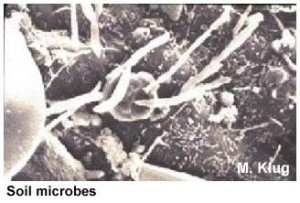At first glance, soil appears to be quite lifeless, however, when you look at it under a microscope you find that it is anything but. In a single teaspoon of soil it is estimated that there are billions of microbes. Microbe populations include fungi, bacteria, protozoa, actinomycetes and nematodes. The area around the plant roots become a hotbed of microbial activity and adding carbon to the soil surrounding roots greatly increases the number of microorganisms. Much of this added carbon comes from root exudates. These are a gel-like substance that is produced by plant roots. In some plants as much [1] as 1/3 to ½ of the carbon produced during photosynthesis is exuded through the roots.
[1] as 1/3 to ½ of the carbon produced during photosynthesis is exuded through the roots.
Many factors can affect this microbial activity including moisture, pH, soil texture and soil structure. Improved soil structure increases root growth and results in greater extraction of water and nutrients. Greater soil aggregation results in better porosity which means potentially more water holding capacity or greater soil aeration. Gypsum improves soil structure and soil aggregation, thus can greatly enhance microbial activity. Some studies have shown that by improving soil structure, less soluble phosphorus is required for plant growth. This could be related to improved root growth plus increased microbial activity around the roots increasing nutrient uptake.